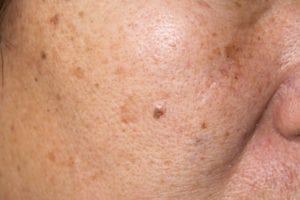Whilst cosmetic products are designed to maintain or improve skin health and appearance, how do we demonstrate this? Over the past two centuries, dermatological research has clearly identified parameters that affect skin health and their way of function. Below we are going to discuss some of the most important parameters for healthy skin and how they influence the formulation of cosmetic products
Skin pH
The pH is scored on a scale from 0 to 14 with the neutral point being 7. Values over pH 7 indicate basic conditions and values under pH 7 indicate acidic conditions. The further the value is away from the neutral point, the stronger the acidity or basicity (the latter is also known as alkaline). The pH level of skin surface normally ranges between 4 and 6, which means that it is typically slightly acidic. This helps protect against microbial pathogens that can cause disease. The slightly acidic skin pH also stabilises the skin’s barrier function which prevents water loss from the inside and penetration of pollutants or irritants from the outside. Thus, the protective function performed by the skin’s acid mantle is weakened by changes in the pH value. Such change can cause skin infections, dehydration, skin irritations and allergies. Skin care products can alter the pH of the skin surface. Soaps for example, are basic and can increase the normal skin surface pH, which may result in a higher risk of damaging barrier function and a reduction in anti-microbial protection. The measurement of the pH-level on the skin surface is an important parameter for evaluating the nature of the skin surface in relation to the use of a cosmetic product. Cosmetic products that least alter the normal skin surface pH are generally considered better for our skin.
Skin Sebum
Epidermal surface lipids (sebum) have an important role on normal skin function. Elevated sebum excretion (oily skin) is a major factor involved in the pathophysiology of seborrheic skin and acne. On the other hand, insufficient skin sebum level results in dry skin, which can lead to dermatitis and bacterial infections. Sebometry is a skin bio-engineering technique used to measure skin surface lipids quantitatively. The advantage of using instrumental readings in place of observational methods is the prevention of misdiagnosis through the objective measures of oily, normal or dry skin. In particular, sebometry can assist in demonstrating the sebum normalizing properties of a cosmetic product. In addition, sebometry is largely used to help monitor a cosmetic product’s long-term effect on the skin sebum level.
Skin Hydration
‘Skin Hydration’ can be defined as the process of providing adequate amount of liquid to the skin. To hydrate or moisturise means to restore or maintain fluid balance. When skin is properly hydrated, it is better protected against environmental influences. It feels smooth and plump and somewhat bouncy to the touch. When it is not, the skin can be tight, flaky and dull. These effects are also normally due to skin aging. From a cosmetic point of view, hydrated skin looks healthier and younger. But also, skin that is regularly moisturised has been known to ‘age’ slower than the non-moisturised skin. Measurement of the hydration level of the stratum corneum provides an important indicator for the health of our skin. Moreover, it has significant applications with regards to the evaluation of the efficacy of a cosmetic product.
Trans-Epidermal Water Loss
Stratum corneum is the Latin name for horned layer and represents the outermost layer of the skin epidermis. It performs an important barrier function which protects underlying tissue from infection, dehydration, chemicals and mechanical stress. The measurement of trans-epidermal water loss (TEWL) is the most important parameter for evaluating the efficiency of the skin water barrier. TEWL is defined as the measurement of the quantity of water that passes, from inside the body though the epidermal layer to the surrounding atmosphere (via diffusion or evaporation). In healthy skin, trans-epidermal water loss (measured in terms of water evaporation from skin surface) is low – generally < 13g/m2-h. By measuring the TEWL the skin response to cosmetic treatments may be examined. Considerable lowering of TEWL (compared to before treatment) after the use of a cosmetic product indicates that the product is occluding the skin surface. A shift from high TEWL to more normal/low values suggests that the cosmetic product is efficient in restoring the skin barrier function. On the contrary, a shift from normal/low TEWL to high TEWL suggests that the skin barrier has been damaged.
Understanding the skin is very important not only for people involved in the skin care industry, but also for the consumers that want to look after their skin. Although dermatological research has made huge advances in the past century, a lot is yet to be discovered about the skin and best ways to take care of it. Learning more about the skin will lead to treatments that are more effective for a larger number of people. Better understanding of the differences, as well as the similarities, in different people’s skin, will ultimately help consumers choose products that better suit their needs.




